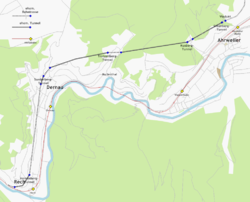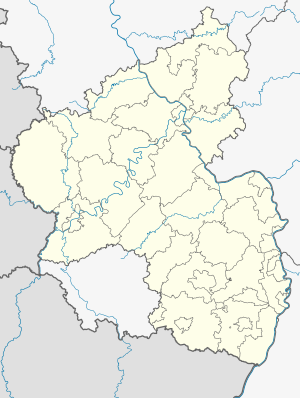Silberberg tunnel
| Silberberg tunnel | ||
|---|---|---|
|
East portal of the Silberberg tunnel
|
||
| place | Bad Neuenahr-Ahrweiler | |
| length | 660 m | |
| Number of tubes | 1 | |
| map | ||
 Silberberg Tunnel (top right) in the southern part of the Strategic Railway Embankment
|
||
| location | ||
|
|
||
| Coordinates | ||
| East portal | 50 ° 32 '42 " N , 7 ° 5' 22" E | |
| West portal | 50 ° 32 '31 " N , 7 ° 4' 54" E | |
The Silberberg Tunnel is an approximately 660 meter long tunnel through the Silberberg near Bad Neuenahr-Ahrweiler . Today, the Silberberg Tunnel memorial at the former east portal commemorates the protection that the structure provided to 2500 people during the Second World War .
history
The tunnel was created for the railway line of the Strategic Railway Embankment , which was built from 1910, but it was never provided with tracks due to a construction stop in 1923. To the west of the structure is the Kuxberg tunnel , to the east the Ahr wine-growing area was to be spanned by the Adenbach viaduct , of which only the pillars were built.
After the construction freeze, the tunnel was empty. In the mid-1930s, a mushroom cultivation was set up to reduce imports of the noble mushroom from France . For this purpose, the Ahr-Edel-Pilzzucht-GmbH was founded under the direction of the Ahrweiler Mayor Eiden .
In the last years of the war, the residents of Ahrweiler sought protection from bombing attacks and built temporary wooden dwellings, known as “Büdchen”, in the tunnel. A "city in the mountain" was created, which in the meantime offered protection for 2,500 people. In the middle of the tunnel, Adolf-Hitler-Allee was kept free so that bicycles could be used; all houses were marked with house numbers. Lice and fleas were found in the narrow huts , but the population preferred life in tunnels to the danger of air raids. Nonetheless, 86 people died in the bombing raids on the old town of Ahrweiler on January 29, 1945. In the unused tunnels of the strategic embankment, armaments were manufactured as part of the U relocation , including forced labor . A makeshift electrical supply for the tunnel city was set up from the production facilities.
Silberberg Tunnel Memorial
On July 3, 2004, a small open-air museum was opened as a memorial at the former east portal by the Alt-Ahrweiler Heimatverein . It can be reached via the red wine hiking trail . The entrance to the museum in the government bunker is located in the immediate vicinity of the blown west portal .
literature
- Mathilde Husten: The city in the mountain: a novel . ARE-Verl., Bad Neuenahr-Ahrweiler, ISBN 3-9802508-7-3 .
Web links
Individual evidence
- ↑ a b c The Tunnel Memorial ( Memento of the original from April 1, 2011 in the Internet Archive ) Info: The archive link was inserted automatically and has not yet been checked. Please check the original and archive link according to the instructions and then remove this notice. , accessed May 14, 2012
- ↑ Die Stadt im Berg ( Memento of the original from November 15, 2011 in the Internet Archive ) Info: The archive link was automatically inserted and not yet checked. Please check the original and archive link according to the instructions and then remove this notice. , accessed May 14, 2012
- ↑ a b The city in the mountain urges peace . In: General-Anzeiger , March 4, 2005. Retrieved May 14, 2012
- ↑ Memory of the blackest day in Ahrweiler . In: General-Anzeiger , January 28, 2012
- ↑ The tunnel bunker became a memorial . In: Heimatjahrbucharchiv of the Ahrweiler district. Retrieved May 14, 2012

